LINK TO HOME PAGE/CONTENTS: HOME PAGE – CONTENTS
Contents © 2016 Harold Pfohl
Fire was a gut fear of all farmers. A barn fire was catastrophic. The Lueder family experienced such a fire in 1922. In addition, new shelter was needed for the increasing amounts of machinery that became available to farmers and greatly facilitated the efficient execution of their labors. The equipment could not be left out in the open exposed to the elements.
This post looks at what was involved nearly a century ago for a family that lived through a barn fire and then via adaptive reuse converted a horse barn/pigsty to a machine shed.
WHERE THEY LIVED
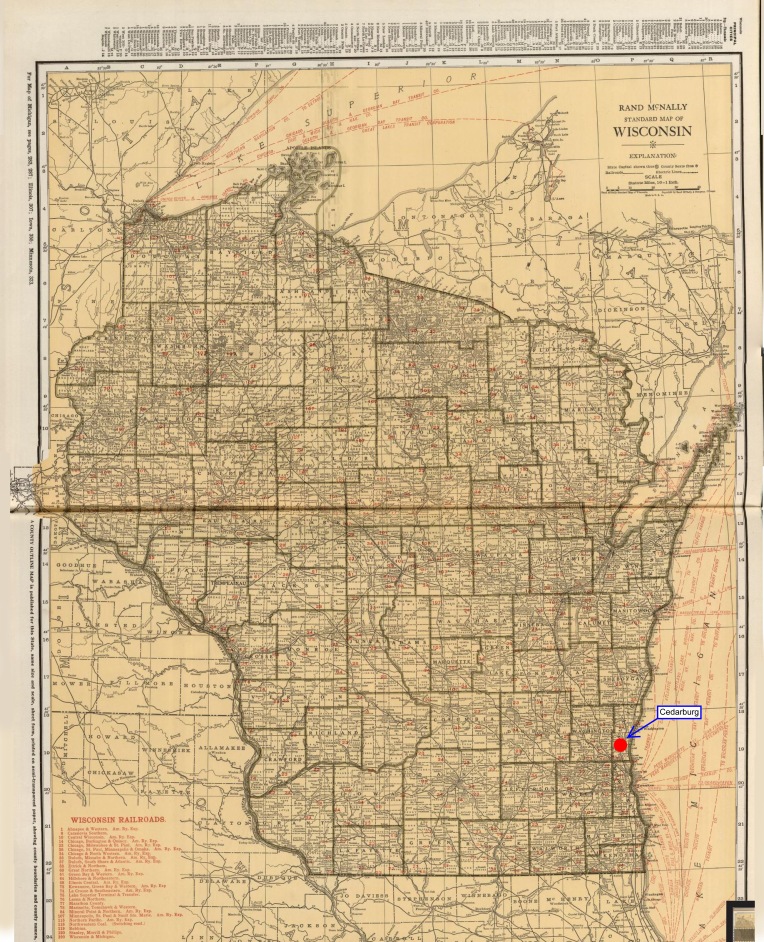
Wisconsin, 1924 – Source – David Rumsey collection
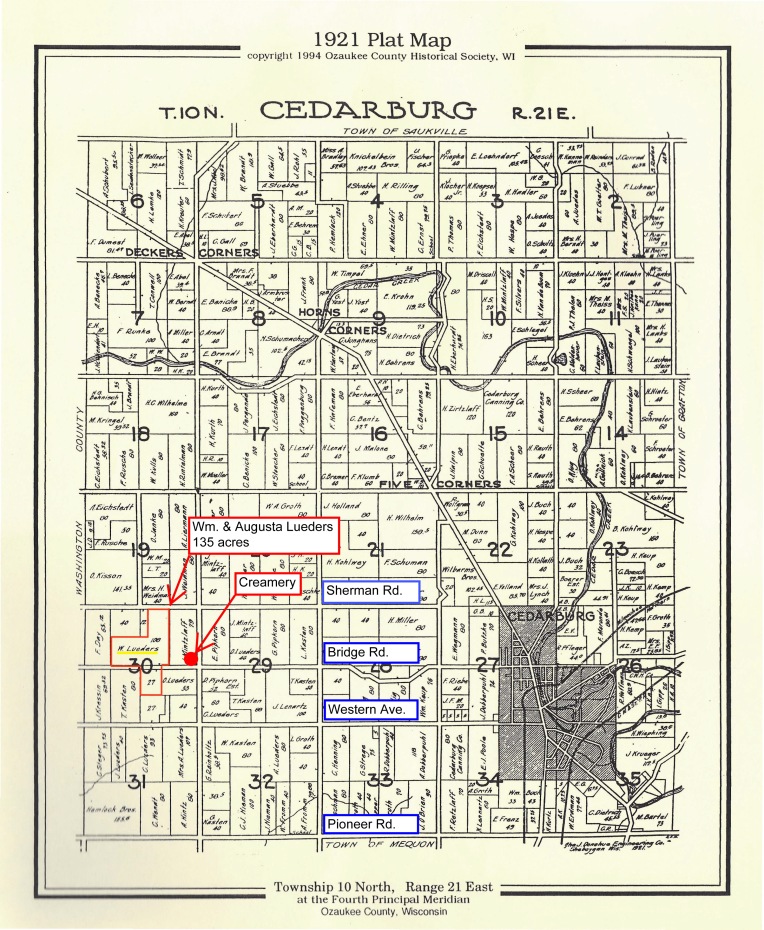
Location of the William and Augusta Lueder dairy farm Courtesy of Steve Lueders, Source – Ozaukee County Historical Society
A GUIDE TO THE FAMILY
See: 1900 – 30s – GUIDE TO THE WILLIAM & AUGUSTA LUEDER FAMILY
AMBITION
William was ambitious. His father and grandfather had pioneered and assembled the largest landholdings in the township – 240 acres. In 1899 the barn was raised to provide an extra floor of space for expanded operations. In the early 1900s William purchased 40 acres from his neighbor, Tom Mitchell. He built a new silo – an expensive proposition – to accommodate the increased harvest from his expanded holdings.
THE NEW SILO
The new silo was made of wooden staves on a concrete base – think of a gigantic barrel 30 or 40 feet high. It blew over in a severe windstorm in 1918. It was essential to operations and was promptly rebuilt.
THE OLD BARN
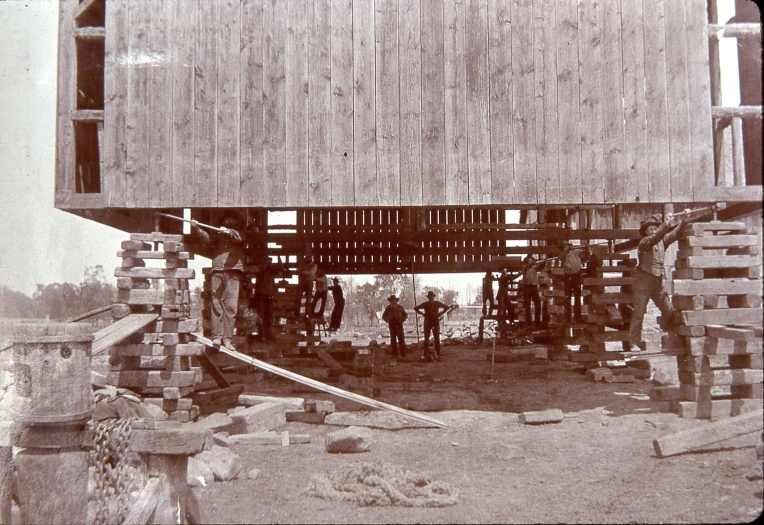
Charlie Nieman photo
The old barn was very likely the same building that had served the farm since it became part of the family holdings in the 1850s. It was no longer large enough to serve the expanding needs of the farm and William’s ambitions. It was obsolete.
The photo above and the enlargement below show the old barn in 1899 when it was raised to become a two-story building. Hay and grain and grain bundles were stored on the second floor. It was connected to a two story granary.
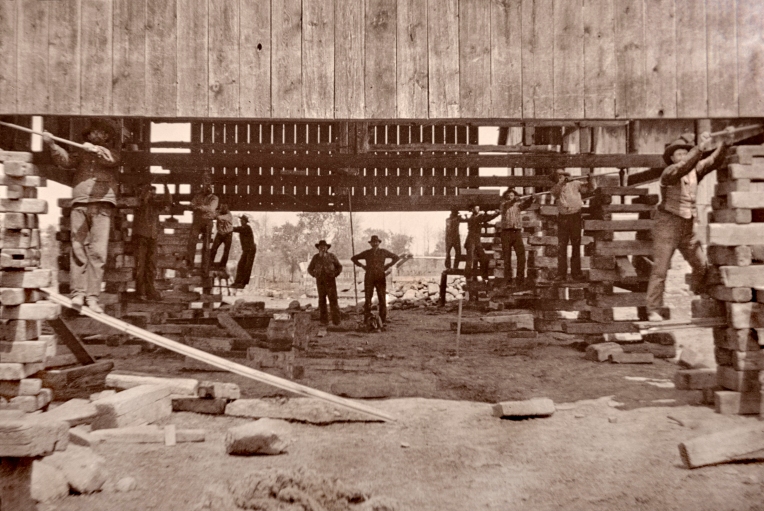
The strength of the barn floor for heavy loads was questionable and left William ill at ease when it supported heavy loads, e.g., the threshing machine seen in the previous post (shown in the new replacement barn) See: EARLY 20TH CENTURY – PART FIVE – MAKING A LIVING CONTD – PLANTING AND HARVESTING – HARD WORK FOR MEN, WOMEN AND CHILDREN
Viola: “The old barn was a two-story building. On the west was the dump, the man-made hill to the second floor of the barn. …. On the second floor the hay was stored. The horses had to pull hard to pull the wagon loaded with hay or grain bundles up into the barn. …Up under the roof of the barn the hay fork hung. It was used to unload the hay from the wagon.”
“…the day before the threshing rig would come Pa had to put extra supports under the barn floor in the barn so that the machine would not be in danger of falling into the lower part of the barn.… When he {Tim Dobberpuhl – owner of the steam engine and threshing rig} came to Pa’s farm, he would stop at the… line fence and fire up. He needed extra power to push up the threshing machine on the rather steep dump at the barn.”
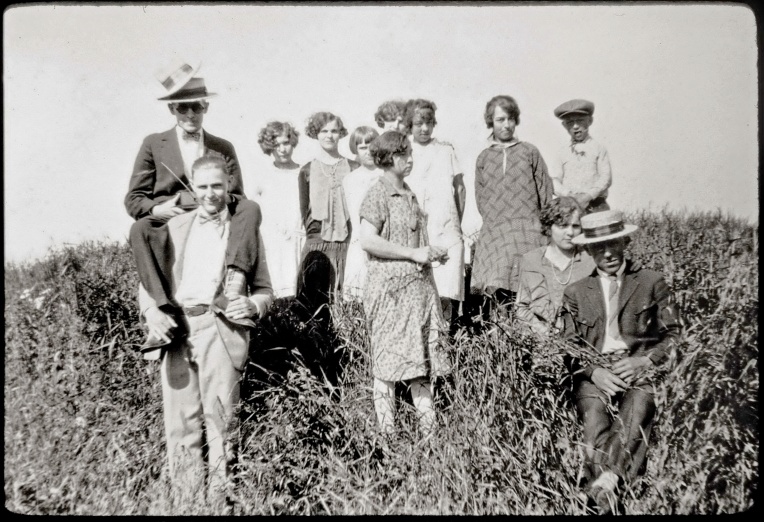
On the “dump” or ramp to the second floor for the old barn. A very steep little man-made hill – late 1920s – Source – family photo
In order to haul wagon loads of hay and grain bundles up to the second floor an earthen ramp was built on the west end. It was very hard for the horses to pull wagonloads of hay or grain up that ramp. The photo shows a considerable grade. The barn doors to the second floor were at the top of the hill.
Viola: “The house and barn were rather far apart. In fall and winter when it was dark early they had to light the two lanterns to light the way and also to have light in the barn, for doing the milking. The kerosene lanterns did not throw off much light. Often in the strong wind the lanterns would blowout.”
“The old barn was quite a long way from the house and milk house. It was a long walk to carry the milk from the barn to the milk house especially in winter. Sometimes in winter we, that is Cordelia, I, and Gerald would go along to the barn in the evening at milking time. We would play hide and seek. There were plenty of dark corners to hide in. There were always plenty of cobwebs around and we were careful not to go close to them for fear of spiders lurking around. We would also play with the cats.”
“The barn and the granary were connected at one corner. It was also a two-story building. The top floor was the granary with large bins for grain storage.… After threshing when the oats was clean we children would play in the grain. Pa would let us only romp in the old spin. After a while when the cats used it for their purpose, we did not go in anymore.”
POWER SOURCE
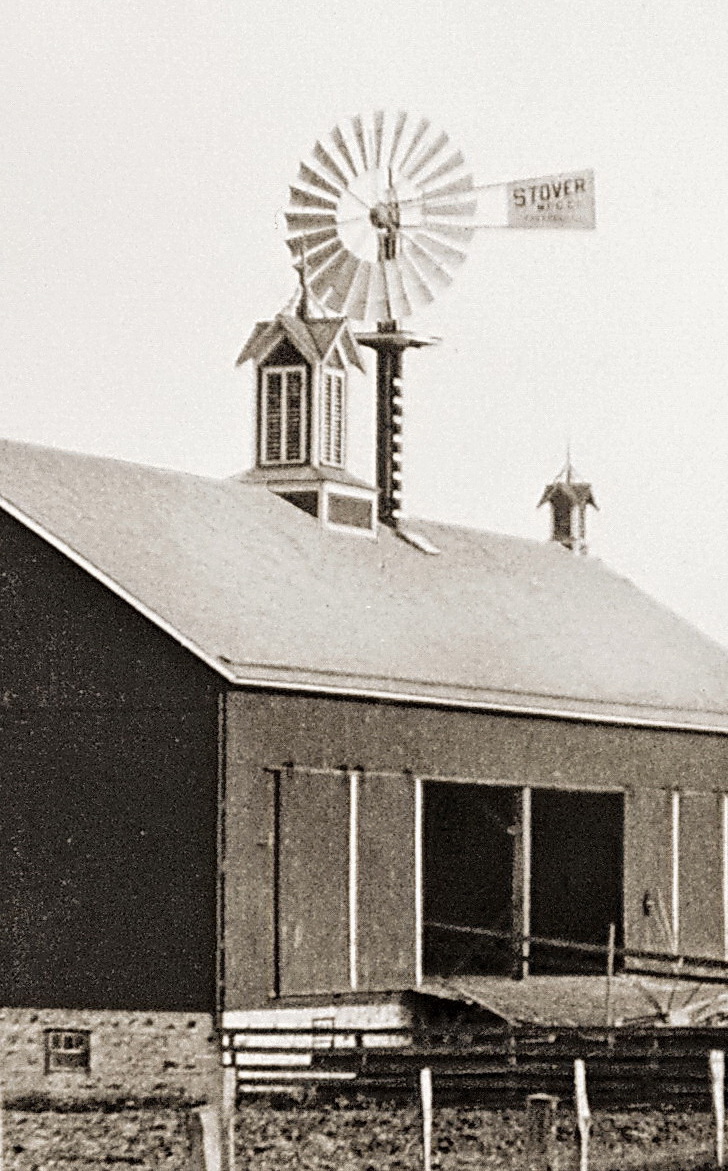 Photo – Charlie Nieman
Photo – Charlie Nieman
The barn shown above was on Charlie Nieman’s farm. The purpose of the image is to show the windmill rising out of the roof. Lueder’s barn had the same arrangement. The windmill was large and provided considerable power to machinery within the barn for whatever stationary equipment needed to be operated.
Viola: “There were two windmills on the farm. One was over the well house. The other one was on top of the barn. This windmill was used to drive the feed cutter. The feed cutter cut up dry cornstalks for the cows and old bundles to feed to the horses. This was called hexel, a low German word”
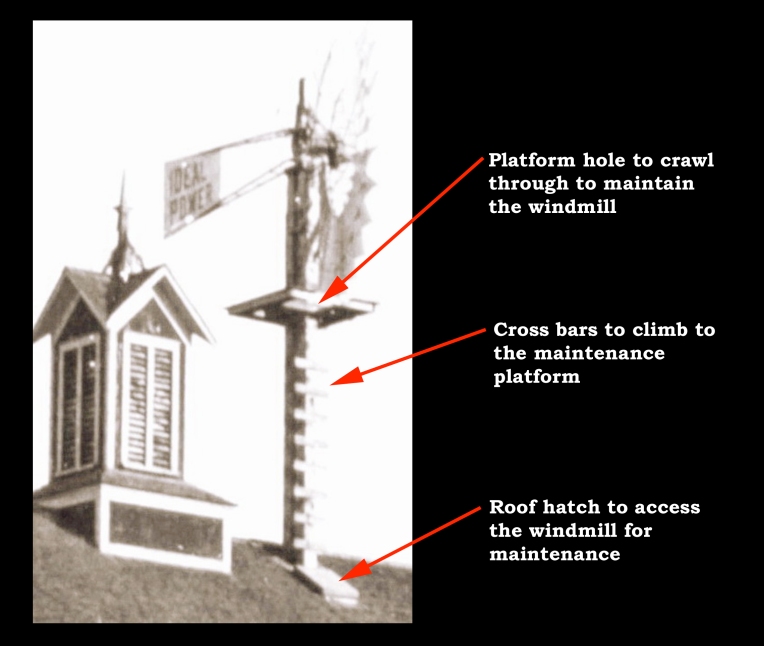
Charlie Nieman photo
The bearings on the windmill needed periodic greasing and other parts would need replacement over time. Safety in design was many decades into the future. The windmill was immensely useful and more than a little dangerous to service for maintenance.
EXPANDING ARABLE LAND HOLDINGS – OCTOBER 24, 1922
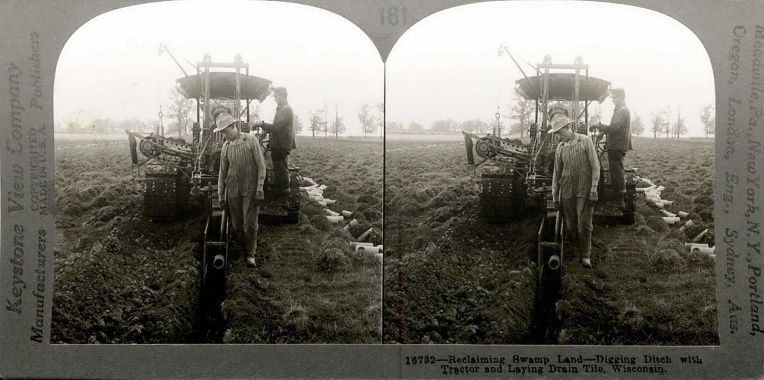
Laying drain tile to recover arable land, about 1920 – Source – author’s collection
This stereograph from Wisconsin shows a machine that dug a narrow ditch and then placed drainage tiles into the ground. Lueders contracted for such work to be done on the north side of their barn in October of 1922. The tiles formed a long, porous tube leading to a swamp 200 yards north of the barn. The water from the saturated soil seeped into the tube, and land which had often been too wet for equipment and crops became arable.
William’s effort to increase his acreage had disastrous consequences.
INFERNO – OCTOBER 24, 1922
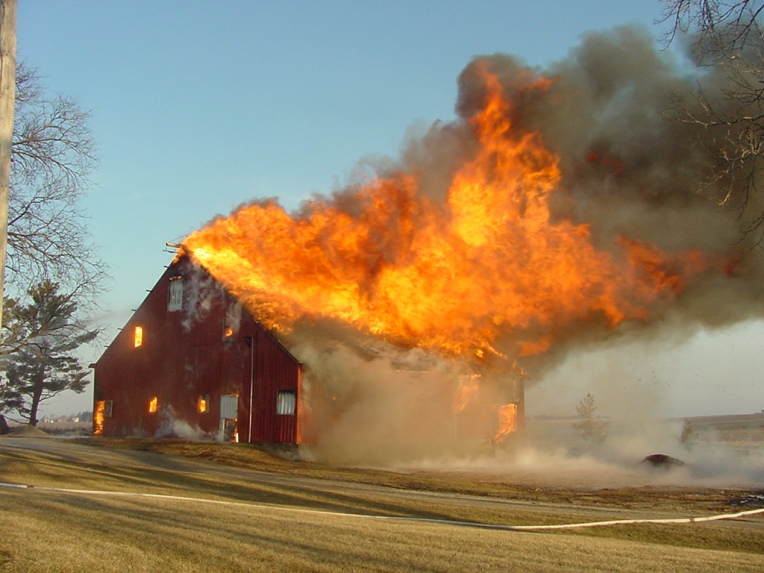
Their barn burned to the ground on Wednesday, October 24, 1922. – Source – garystrattonfirefighter.com
A gasoline engine started the fire. Near the barn, drainage tiles were being placed in a ditch to create arable land, and sparks from the ditching machine 4 cylinder gas engine found tinder at the barn, which soon was blazing. Neighbors helped by wetting the roofs of nearby buildings to prevent them from burning. Edgar Lueder recalled a man climbing a ladder while carrying a milk can full of water in each hand, a feat of extraordinary strength.
Fire in a barn filled with tinder dry hay becomes an incredible inferno. William and Augusta’s barn would have most certainly presented a sight similar to that above. It was a horror show, catastrophic. The means of making their living, the shelter for their animals, the hard labor of a year of plowing, planting, cultivating and harvesting torched into a raging blaze.
One of the most appalling emotional aspects of a barn fire was that the horses struggle to get into the barn where they believe they will be safe. A farmer’s nightmare was hearing the animals scream as they were burned alive. William’s horses were spared – the horse barn was separate from the cow barn.
Viola, Cordelia and Gerald were at school and had seen a great deal of smoke on the skyline all afternoon but had no idea what was happening. Gerald, age 10, and his cousin Arnold Lueders, 13, were sent by the teacher to a neighboring farm for some tools to use at school and they returned in a panic with Gerald yelling “Unserer scheune ist abgebrannt!” (Our barn is burnt down). The children and teacher dropped everything and ran across the fields to the inferno.
The barn, filled with an entire season’s harvest of bone-dry hay, was impossible to save; it was a complete loss. That evening William came into the house and said to the family in Low German, “I guess we don’t pray enough.” The granary had been part of the barn, and the grain smoldered and burned for weeks, an ugly reminder of the disaster.
Adding insult to William and Augusta’s gloom and misery, some people had the gall to suggest that William had lit the fire for the insurance.
AFTERMATH
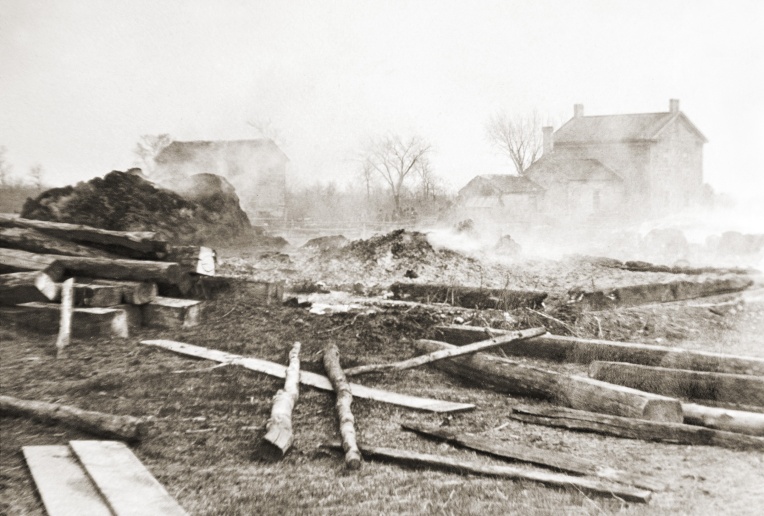
A barn fire in the neighborhood, aftermath – photo by Charlie Nieman, 1890s/1900
William’s livestock were distributed among relatives and neighbors for the winter except for 12 cows, which he was able to keep in his horse barn, shown lower in this post.
Viola: “… the winter after the old barn burned down. It was a hard one for our Pa. With help he fixed up the old horse barn so that he could keep some cows at home. There was room for 12 cows.”
“Uncle Charlie Nieman boarded the heifers and neighbors took some cows in and boarded them for the milk that the cows gave. In spring they were all brought back again.”
“During the Christmas week in the year 1922, Edgar, Renata, and Elda were at a wedding and Pa had to do the chores alone. It was a dark and dreary night. When it was time to milk the cows, that were housed in the old horse barn, Pa asked me to go along with him and hold the lantern while he milked the cows. Believe me, I held tight to that lantern. To me that night was an eerie one.”
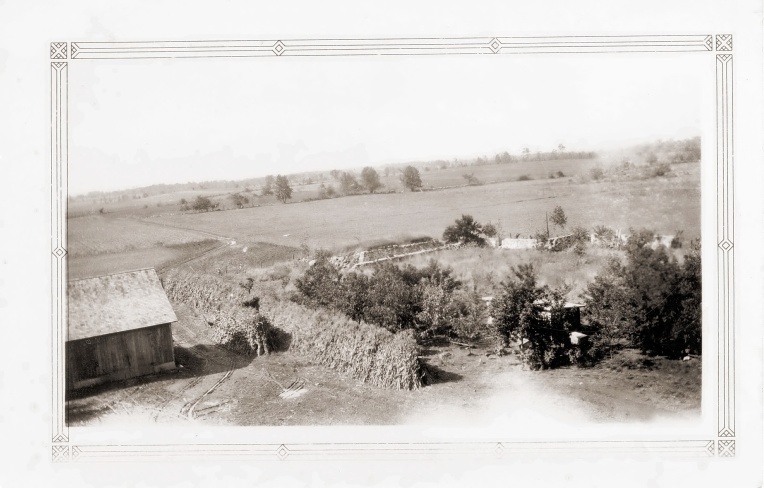
Photo of old barn walls taken October, 1930, from the top of a silo on the new barn built to the east – Source – family photo
The “dump” ruin/remnant is the high wall at the upper center of the picture.
Note the corn “shocks” lined up and stacked at the lower left hand corner. They could remain like that for quite some time without spoilage.
BARN RAISING – JUNE 8, 1923
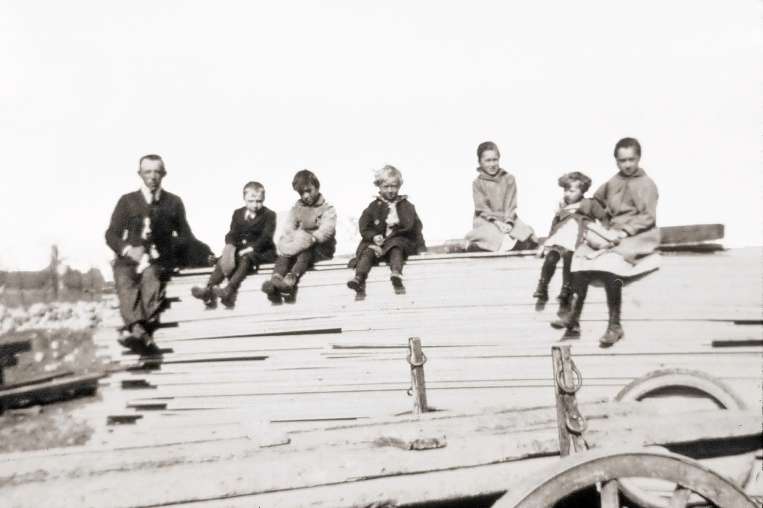
Lumber pile for construction of the new barn – before June 8, 1923 – Source – family photo
L-R: Edgar (23 yrs old) with Rover, – ? – Gerald (11 yrs), Harold (7 yrs) Cordelia (13 yrs) – ? – Viola (15 yrs)
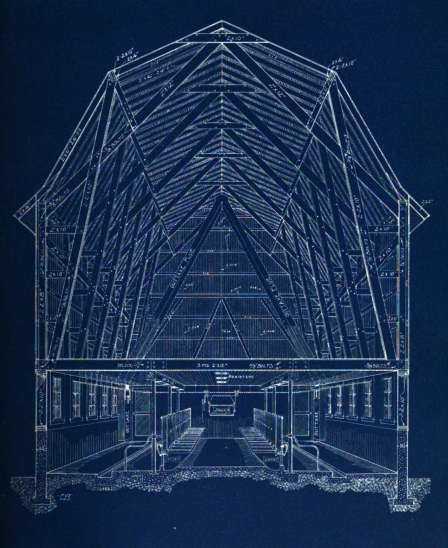
Blueprints for a barn nearly identical in design to the new barn – Source – bricoleour.org
The architecture and engineering was not simple.

Barn raising – Source – family photo
L-R: Cordelia, Harold & Viola, “Ma” Augusta, Elda, Renata – Click to enlarge
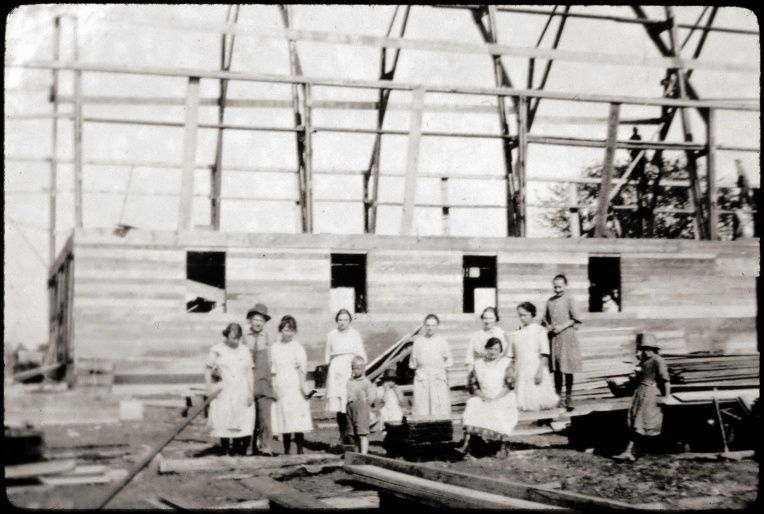
Barn raising – Source – family photo
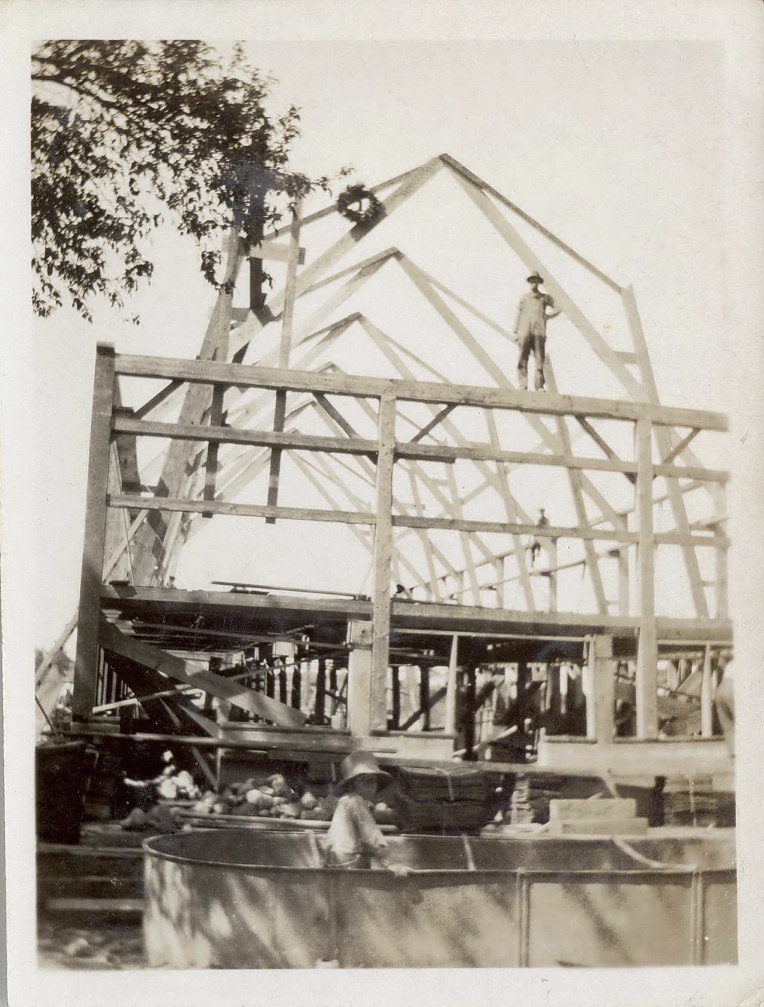
Barn raising – view from the south. Note the wreath at the top left of the barn.
Thirteen year old Cordelia is in the cow tank wearing the big hat, and paying close attention to the grand project.
Fortunately, Lueder’s old barn was insured. The first order of business the next spring after the fire, weather permitting, was to build a new one.
Young Robert Krause, a highly skilled carpenter, was trying to start his own business and wanted to bid for the construction contract. William didn’t want to take a risk on a new businessman; he wanted a veteran and turned Robert down. Robert was unable to get enough independent work to keep himself much less a crew employed, and had to go back to work for a contractor. That contractor turned out to be the firm that William retained to build his new barn, and the contractor’s employee, Robert Krause, superintended the project.
Raising the framework comprising the trusses, joists and rafters required the help of numerous men, laboring under the direction of skilled carpenters. Neighbors would gather together to help on such an occasion, and it was turned into a festive event.
When the barn was completed, relatives, friends, and neighbors were invited to celebrate with a dance. The wooden floor of the haymow upstairs was washed and waxed, the trusses were decorated with green boughs, and at one truss, a wreath and wine bottle were hung. The whole event was similar to the christening of a ship, and at the moment of “dedication” the bottle was smashed.
The dance was restricted to invitees only, with Harvey Groth screening the arrivals and bouncing any party crashers. Roland Nieman and Erwin Mueller provided concertina music. Refreshments were abundant. Walter Keup and Henry Retzlaff tended bar but served only lemonade, no beer! It was a grand party. The burning, rebuilding, and “dedication” were among the most memorable events in the lives of the Lueder siblings.
* * * * * *
William no doubt hoped that the new barn would serve for generations to come, and perhaps even centuries, as many barns in Europe have. However, with the very recent invention of the huge round bales of hay and straw that one sees in fields everywhere, a haymow is not needed and therefore the historic design of barns is now outmoded and fated to disappear. Today the tightly wound hay and straw of the round bales act as thatching and sheds water; the bales form their own shelter.
The barn, now 93 years old, is in good condition but is underutilized. It is interesting to inspect the wooden structural workmanship; it is a marvel. Robert Krause was a master craftsman.
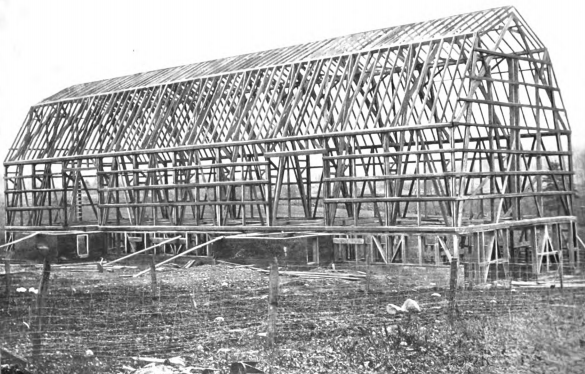
Very similar structure to the Lueder’s new barn – Source – bricoleour.org

The new barn – late 1920s – Source – family photo
Cordelia and Rover – That dog seems to have been in more family pictures than any single family member. Dogs were never, ever allowed in the house.
UNFORESEEN CONSEQUENCES – TWO MARRAIGES
Robert, the builder, was married to a lady by the name of Frieda Heckendorf, and his brother-in-law, Erich Heckendorf, was on the carpenter crew. As a direct result of the barn construction, but at a much later time, Erich married Renata Lueder and Edgar Lueder married Erich’s sister Alice Heckendorf.
MORE CONSTRUCTION – HORSE BARN CONVERTED TO MACHINE SHED AND PIG BARN – MARCH 8-25, 1927
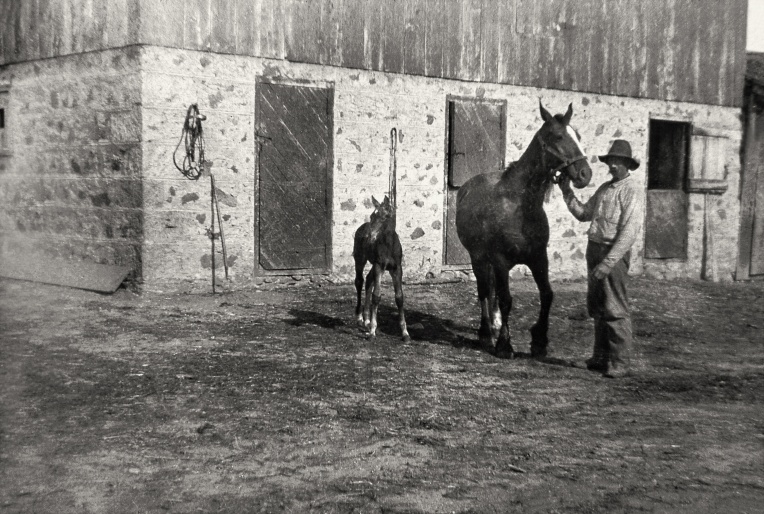
The horse barn/stable shown with William’s brother Otto and a mare and foal around 1900 – Photo – Charlie Nieman
The new cow barn was larger than the old one and had stalls for horses. After the new barn was finished the horse barn was used as a pig sty, which Cordelia refers to in her diary excerpts below as a pig “stable.” The second story which had been used to store feed for the horses was underutilized. A chicken coop and tractor/machinery shed were needed, so the second story of the old horse barn was lifted, moved north, and set directly alongside ground level stone walls to form an elongated one-story building. It was practical, easily done, and comparatively inexpensive.
THE CONTRACTOR INSPECTS THE BUILDING , SHOVELING OUT THE PIG STY
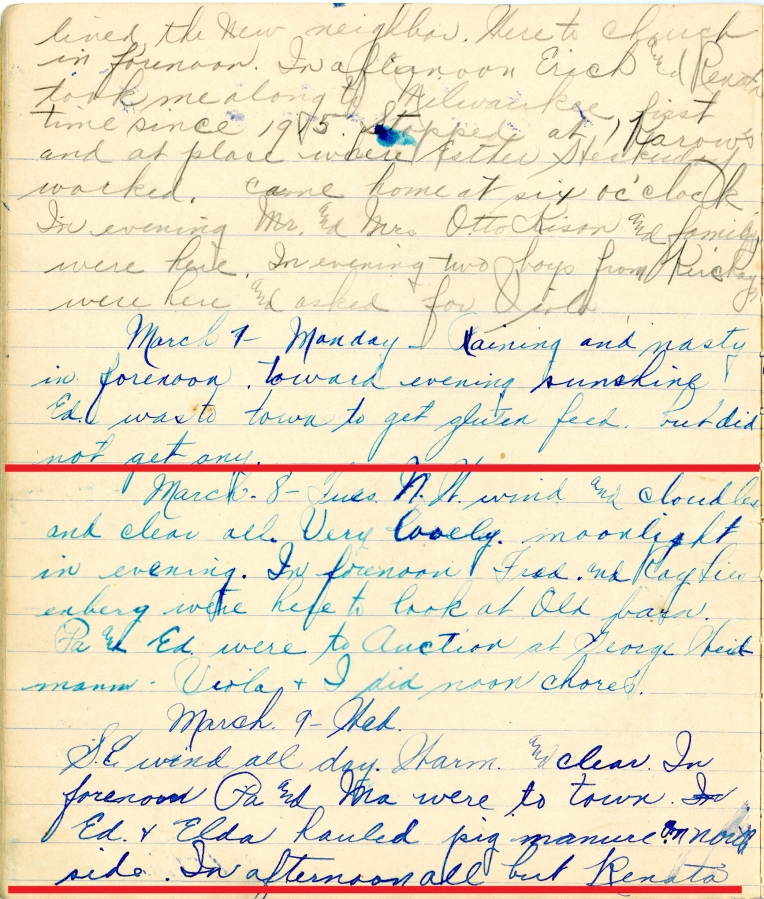
Cordelia’s diary
“March 8, 1927 – Tuesday, northwest wind and cloud less and clear all {day}. Very lovely moonlight in evening. In forenoon Fred and Ray Liesenberg were here to look at old barn. Pa and Ed were to auction at George Weidman’s. Viola and I did noon chores.
“March 9 – Wednesday – Southeast wind all day. Warm and clear. In forenoon Pa and Ma were to town. Ed & Elda hauled pig manure on north side{cleaning out the pig barn}. In afternoon all but Renata, {contd below}””
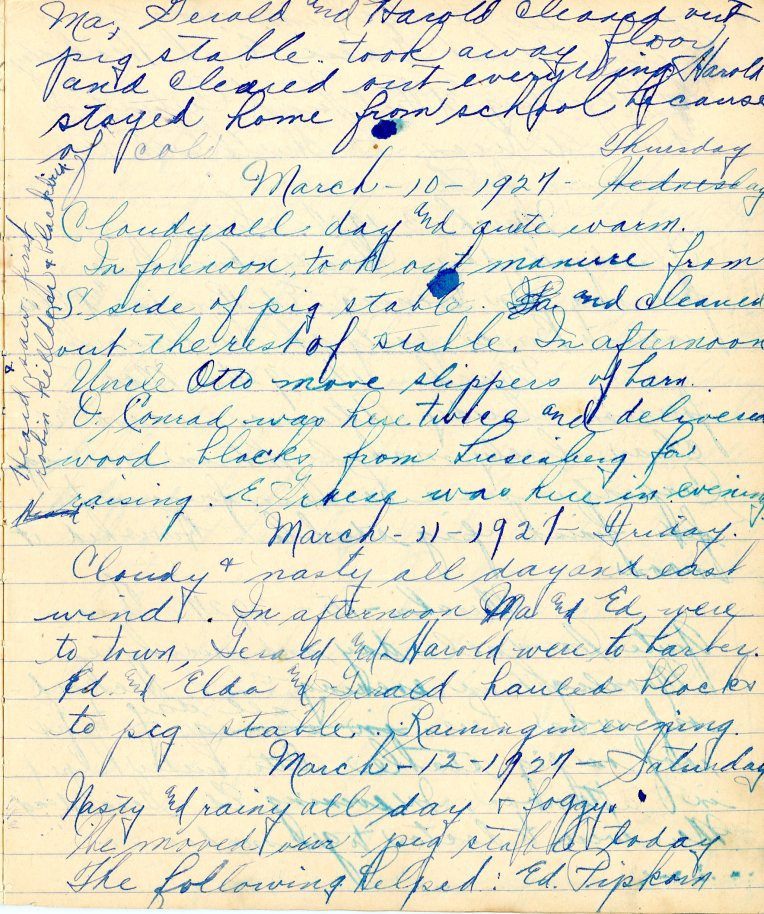
More pig sty cleaning and receipt of the large wooden blocks necessary to move the upper story off the stone walls. Moving the structure is accomplished.
“Ma, Gerald and Harold cleaned out pig stable. Took away floor and cleared out everything. Harold stayed home from school because of cold.”
“March 10, 1927 – Thursday. Cloudy all day and quite warm. In forenoon took out the manure from south side of pig stable. Pa and {?} cleaned out the rest of stable. In afternoon Uncle Otto moved slippers of barn. O. Conrad was here twice and delivered wood blocks from Liesenberg for raising. E. Graese was here in evening.”
“March 11, 1927 – Friday – Cloudy & nasty all day and East wind. In afternoon Ma and Ed were to town, Gerald and Harold were to barber. Ed and Elda and Gerald hauled blocks to pig stable. Raining in evening.”
“March 12, 1927 – Saturday – Nasty and rainy all day and foggy. We moved our pig stable today. The following helped: Ed Pipkorn, {contd. below}”
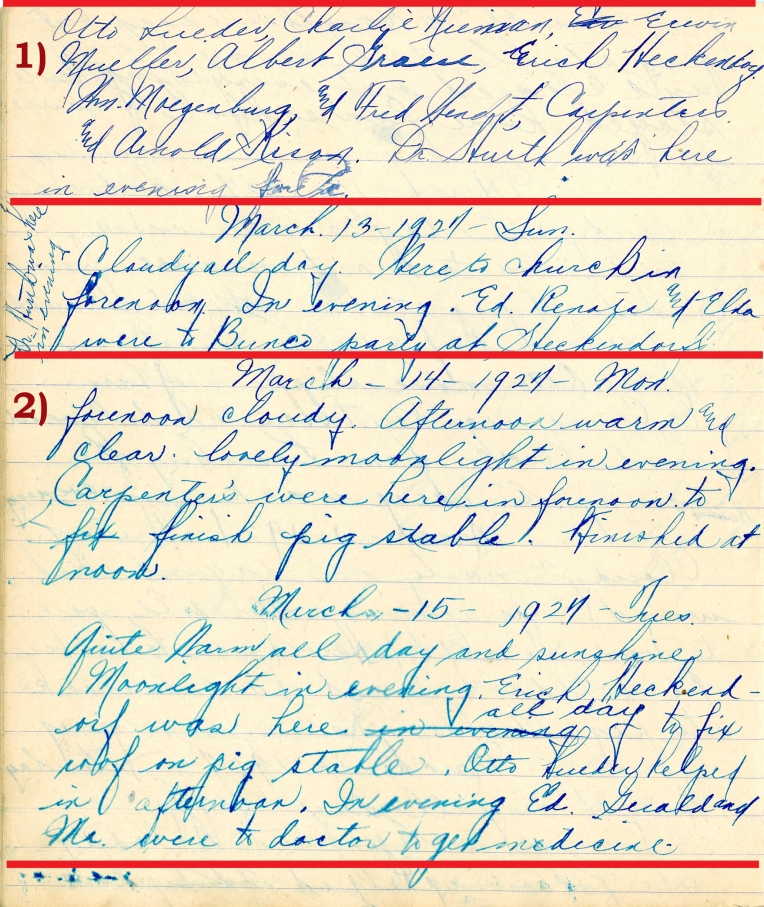
No. 1 above.
Otto Lueder, Charlie Nieman, Erwin Mueller, Albert Graese, Erich Heckendorf, Wm. Moegenburg, and Fred Wendt, carpenters and Arnold Kison. Dr. Hurth was here in evening for Pa.”
The move is finished and carpenters build the roof atop the stone walls.
No. 2 above.
“March 14, 1927 – Monday forenoon cloudy. Afternoon warm and clear. Lovely moonlight in evening. Carpenters were here in forenoon to finish pig stable. Finished at noon.”
“March 15, 1927 Tuesday – Quite warm all day and sunshine. Moonlight in evening. Eric Heckendorf was here all day to fix roof on pig stable. Otto Lueders helped in afternoon. In evening Ed, Gerald, and Ma were to Dr. to get medicine.”
POUNDING NAILS IS NOT JUST A MEN’S JOB
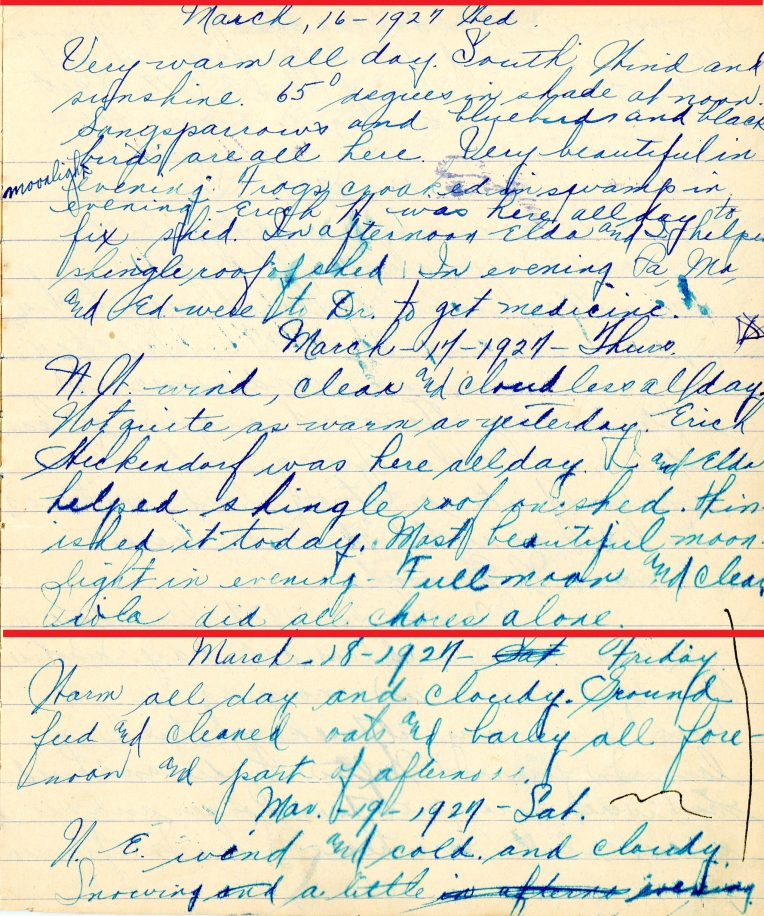
The girls shingle the pig barn roof.
“March 16, 1927 – Wednesday Very warm all day. Southwind and sunshine. 65° in shade at noon. Song sparrows and bluebirds and blackbirds are all here. Very beautiful in moonlit evening. Frogs croaked in swamp in evening. Eric H. was here all day to fix shed. In afternoon Elda and I help shingle roof on shed. Evening Pa, Ma and Ed were to Dr. to get medicine.”
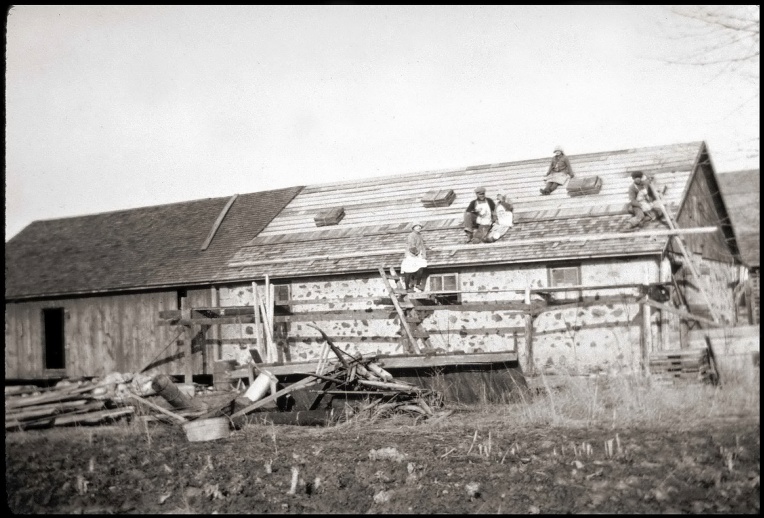
L-R: Viola Lueder, Erich Heckendorf, Elda, Cordelia, & Edgar Lueder
“March 17, 1927 – Thursday – Northwest wind, clear and cloudless all day. Not quite as warm as yesterday. Eric Heckendorf was here all day. I and Elda help shingle roof on shed. Finished it today. Most beautiful moonlight in evening. Full moon and clear. Viola did all chores alone.”

L-R: Cordelia, Erich Heckendorf, Elda, Edgar, and on the ladder, Viola
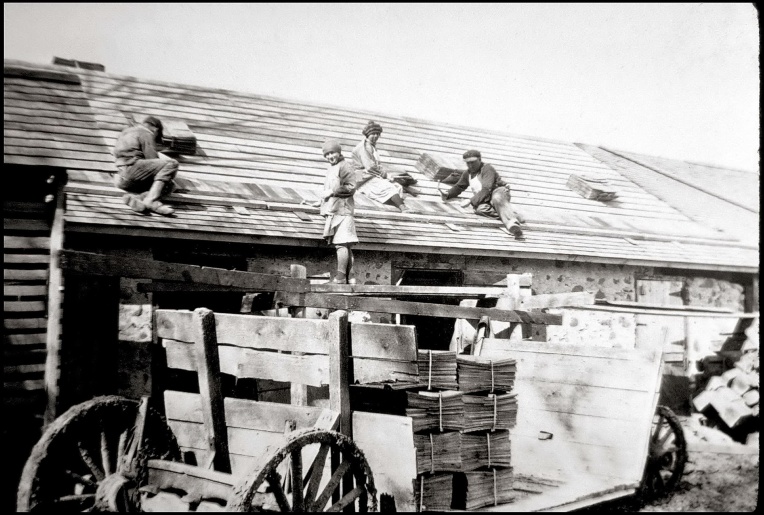
L-R Edgar, Cordelia, & Elda Lueder and Erich Heckendorf
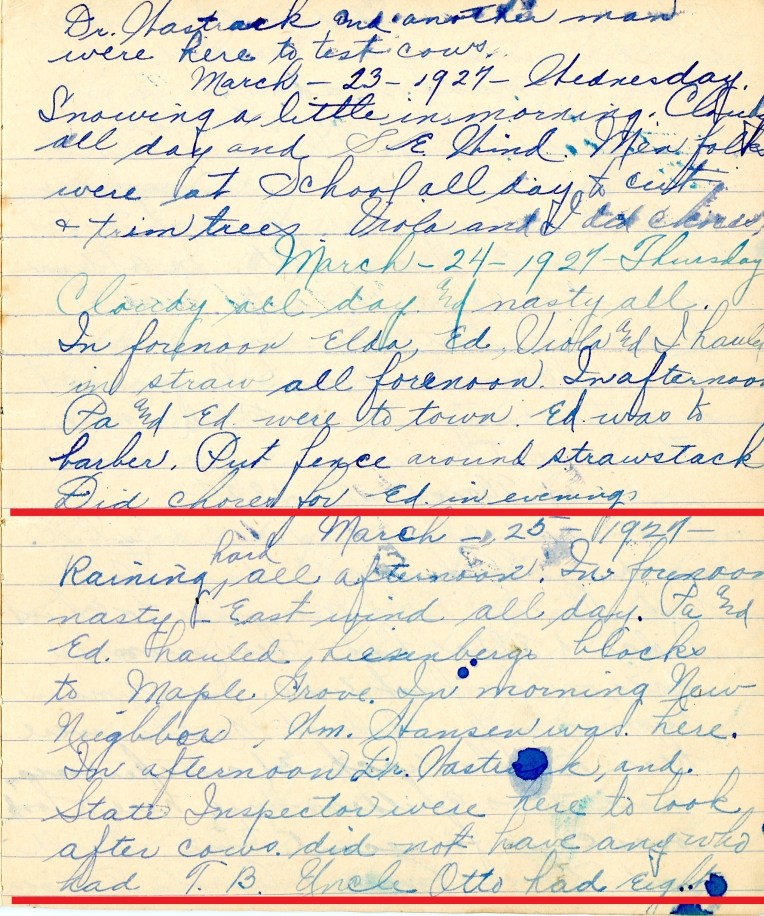
Finishing the project – transport of the wooden blocks.
“March 25, 1927 – raining hard all afternoon. In forenoon nasty – East wind all day. Pa and Ed hauled Liesenberg’s blocks to Maple Grove. In morning new neighbor Wm. Hansen was here. In afternoon Dr. Wastrack, and State Inspector were here to look after cows, did not have any who had T.B. Uncle Otto had eight {T.B. cows}”
NEXT – WOMEN’S WORK – IT WAS UNIVERSAL, & ENDLESS





Thank you so much for the story of German immigrants in America. I’m totally blown away by the beautiful photographs and the documentation of the different events that took place over the years. I believe I have missed a few of the earlier posts and will try to catch up. It’s just wonderful what you are doing to keep the memories alive. My only regret is that it’s not written in German so that I could link my German farmer friends to your blog.
LikeLike
Ursula – many thanks for your comment and apologies for the tardy reply. My hope in doing the blog was to provide via one family’s experience a story that many German-American’s could relate to. I hadn’t given any thought to the idea of doing the posts in German. That’s a great idea but has a major impediment which is that my knowledge of the language is very limited. I learned German before English but that ceased quickly. I was born in 1942. With the influence of English radio, newspapers, schools, church and with the war, the in home use of German pretty much stopped except for when my parents got mad at me!
Again, many thanks for your thoughts.
Harold Pfohl
LikeLike
Ursula – in addition to my previous comment, with respect to previous posts, click on the “CONTENT” link in the upper right hand corner of the home page. Open that and you can click on and go to any post from the beginning without having to scroll through the whole of the blog. You might find the earliest part regarding their lives in Germany and the immigration to be of interest.
Harold
LikeLike